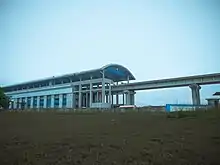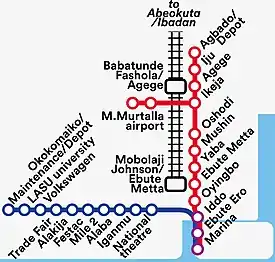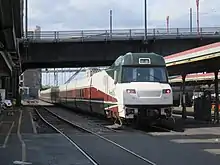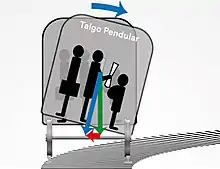Lagos Rail Mass Transit
Lagos Rail Mass Transit is a rapid transit system being developed and under construction[2] in Lagos State. The rail system is being managed by the Lagos Metropolitan Area Transport Authority (LAMATA).[2] The railway equipment including electric power, signals, rolling stock, and fare collection equipment will be provided by the private sector under a concession contract. LAMATA is responsible for policy direction, regulation, and infrastructure for the network. The first section of the network, Phase I of the Blue Line, was originally planned to be completed in 2011, though the construction has suffered many delays caused by shortage of funds and change of government. In February 2021, the Lagos State Government announced that the Blue and Red Lines would be open by December 2022.[3]
| Lagos Rail Mass Transit | |
|---|---|
 | |
| Overview | |
| Owner | Lagos State (Managed by Eko Rail under Concession Agreement) |
| Locale | Lagos State |
| Transit type | Rapid transit |
| Number of lines | Two under construction (Blue Line and Red Line) |
| Operation | |
| Operation will start | December 2022[1] |
| Operator(s) | Lagos Metropolitan Area Transport Authority (LAMATA) |
| Number of vehicles | 15 four-car BMU CNR Dalian for Blue Line |
| Technical | |
| System length | 35 km (22 mi) (planned) |
| Track gauge | 1,435 mm (4 ft 8+1⁄2 in) Standard Gauge |
| Electrification | 1500 V DC overhead catenary (planned) |
Timeline
- 2008: A metro is proposed for Lagos, allegedly with a completion date of 2011.
- 2009: Construction commences on the Blue Line.[2]
- 2010: Lagos Rail Mass Transit to proceed.
- 2016: Phase I (the Blue Line from Marina to Mile 2) planned to open in December 2016.
- 2018: After an Alstom review of the project, Phase I (the Blue Line from Marina to Mile 2) is now set to open in 2021.
- 2021: The Lagos State Government announced that the Blue and Red Lines will open in December 2022.[4]
- 2022, January: LAMATA purchases two Talgo VIII trains.
History
The idea of developing a rapid transit in Lagos state,dates back to 1983 with the Lagos Metroline network conceived by Alhaji Lateef Jakande during the Second Nigerian Republic.[5][6][7][8] The initial Metroline project was scrapped in 1985 by Muhammadu Buhari at a loss of over $78 million to the state tax payers.[9] In year 2003,the then governor, Bola Tinubu, revived the rail network for Lagos state with a formal announcement of its construction.[10] The initial cost $135 million was proposed for the greater Lagos Urban Transportation Project to be implemented by the newly formed Lagos Metropolitan Area Transport Authority (LAMATA).[10] LAMATA initially concentrated on developing a Bus Rapid Transit system, running from Mile 12 to Lagos Island. In 2008, LAMATA to make progress with the rail project, focusing on the Blue Line and the Red Line.
Rolling stock


In September 2011, LAMATA announced that it would acquire some H5-series subway trains formerly used by the Toronto Transit Commission (TTC). The cars were to be refurbished in the United States and converted to standard gauge before being imported and put into service on the Blue and Red lines. The same contract also included an option for some H6-series subway cars from the TTC, however this has since been cancelled[11][12][13][14] .The trains were built as two-unit married pairs[15] with a driver's cab in the front right corner of each car.[16]
In January 2015, LAMATA opted for Chinese-built trains instead, ordering 15 electro-diesel multiple units from CNR Dalian with an option for 14 more.[17] About 76 H5 cars that had been taken for refurbishment to Buffalo, New York, have been scrapped by August 2015.[18]

In August 2018, LAMATA signed an agreement with Alstom. As a part of the agreement, Alstom conducted a review of the rail lines. After the review of the rail project, which should have initiated passenger activity, the state government said the Blue Line, would now be ready for passenger operation by 2022. This deal also plans for the electrification of a portion of the track.
In January 2022, Governor Babajide Sanwo-Olu visited the US state of Wisconsin, to announce the purchase of two Talgo VIII trainsets for service on the Red Line.[20][21] They had been ordered by Wisconsin for use on the Amtrak Hiawatha Service in 2009, but they were never placed in service, and were instead stored.[22] Talgo VIII cars are based on the unique technology of the Talgo Pendular model, which (similar to a bicycle rider) leans into a curve resulting in less sideways force and a higher comfort for passengers when driving over a curvy track.[23][24] The "leaning" of the car is passive e.g. it happens purely by the resulting force, without electronics, sensors or engines. This makes the Pendular and VIII suitable models for city rail traffic.
Routes
Okokomaiko-Marina Blue Line
In April 2008, the Lagos State Government approved ₦ 70 billion for construction of the Okokomaiko-Iddo-Marina Line, with an estimated completion date of 2011. However, the project suffered many delays due to lack of funds.[25] The opening date was revised to June 2013, then December 2016, then 2017.[26][25] As of November 2016, only 16 km of the 27 km Blue Line had been completed.[26] The contract was awarded to the China Civil Engineering Construction Corporation (CCECC),[26] with advisory services being provided by CPCS Transcom Limited. Lagos State is financing construction of the Blue Line with its own resources. The Blue Line will run 27.5 km from Marina to Okokomaiko, with 13 stations and an end-to-end journey time of 35 minutes. The entire Blue Line will operate over a secure and exclusive right-of-way, with no level crossings and no uncontrolled access by pedestrians or vehicles. The route will run on the surface in the central reservation of the Lagos-Badagry Expressway between Igbo-Elerin Road (Okokomaiko) and Iganmu. The line will then be elevated from Iganmu along the south side of the expressway passing the junction with Eric Moore Road, crossing the south of the National Theatre to Iddo, then south to Lagos Island with a terminal at Marina. A Maintenance and Storage Facility (MSF) will be constructed at Okokomaiko, with a track connection from the Blue Line to the depot.
Agbado-Marina Red Line
The second line, the Red Line, will run from Marina to Agbado. The line will share the right-of-way of the Lagos–Kano Standard Gauge Railway.[27] The Lagos State government purchased Talgo trainsets for use on the Red Line from Wisconsin, United States of America, where they were built and purchased for service between Milwaukee and Madison, but never used.[28]
Blue rail-line Mile-2 -Marina 1st phase hits 80 percent completion-LAMATA
The Lagos State Government has announced that the first phase of the blue rail-line project, running from Mile- 2 to Marina axis, has achieved an 80percent completion rate.
This was revealed as Agence Française de Dévelopment (AFD), an international organization, announced readiness to release funds and technical assistance for the Lagos State Government, through Lagos Metropolitan Area Transport Authority (LAMATA), for the development of eight Quality Bus Passageways, QBCs, and two transport interchanges under the Lagos Strategic Transport Master Plan Project Phase 1, LSTMPP1.[29] AFD is a funding and technical assistance agency that works with partners.
Managing Director of LAMATA, Engr. Abimbola Akinajo, disclosed the blue rail line project completion rate when Chairman of the Lagos State House of Assembly Committee on Transportation, Temitope Adewale, led members on a visit to LAMATA's headquarters, Ketu-Ojota Cloverleaf interchange, Lagos.
According to LAMATA MD, the state is currently constructing the infrastructure for the Blue Line, which would run from Marina, Lagos to Okokomaiko, while the Redline, whose construction is set to begin soon, will share tracks with the Federal Government's Lagos – Ibadan Rail Modernisation project and will convey over one million passengers daily. "The first phase of the Blue rail line – Mile 2 to Marina – has achieved approximately 80 percent on average completion rate, with the remaining works involving the construction of the Marina rail station, completion of piers with the lagoon, and retaining walls," she explained.
Akinajo informed the committee that the state government has a Strategic Transport Master Plan (LSTMP), that details six rail lines and one monorail, 14 Bus Rapid Transit, BRT routes, three cable car projects, and over 20 water routes for implementation.
While announcing the state house of assembly's support for Governor Sanwo- Olu's vision of having two rail lines operational by 2022, Adewale stated that the committee was in LAMATA as part of its oversight functions. Adewale stated that the committee was aware of LAMATA's commitment to providing sustainable infrastructure that would give birth to a world-class multi-modal integrated transportation system. “No matter how many roads you build without thinking of how to move the people en-masse from one point to the other, all the efforts would come to naught,” Adewale stated.
Furthermore, Mr. David Margonszternd, AFD Task Team Leader, stated during a mission of the agency's team to LAMATA that the agency was determined to support Lagos' transportation system and make the city competitive. Margonszternd explained that the AFD would fund two transportation interchanges at Marina and Mile-2, as well as eight passageways for quality bus operations. The bus passageways are: Yaba-Lawanson-Cele and Lawanson-Ijesha, Ojuelegba-Idi Araba-Ilasamaja, Anthony-Oshodi, Oshodi-Onipanu, Ketu-Alepere-Ajelogo, Iyana Ipaja-Ayobo, Iju Ishaga–Abule Egba and Iyana Iba (LASU)–Igando.
Meanwhile, Governor Sanwo-Olu has approved a dedicated security team to monitor transportation infrastructure and enforce existing rules regarding the use of the Bus Rapid Transit (BRT) regulation.
See also
References
- "Lagos says blue, red rail lines will be ready by December 2022". Nairametrics. February 25, 2021. Retrieved March 5, 2021.
- "Lagos Rail Mass Transit". Lagos Metropolitan Area Transport Authority. 2015. Archived from the original on December 1, 2016. Retrieved September 23, 2015.
- "Lagos says blue, red rail lines will be ready by December 2022". February 25, 2021.
- "Lagos says blue, red rail lines will be ready by December 2022". February 25, 2021.
- Gbenga Salau (July 26, 2016). "30 years after… Lagos Metroline still work in progress". The Guardian.
- Bola A. Akinterinwa (1999). Nigeria and France, 1960-1995: The Dilemma of Thirty-five Years of Relationship. Indiana University (Vantage). p. 160.
- Ayodeji Olukoju (2003). Infrastructure development and urban facilities in Lagos, 1861-2000 Volume 15 of Occasional publication. Institut français de recherche en Afrique, University of Ibadan. ISBN 978-9-788-0250-54.
- "Turning Lagos Into a Megacity". PM News. April 14, 2004.
- Farukanmi, Olorunnimbe (January 24, 2003). "Battle of Generals". Vanguard.
- Momodu, Shaka (December 3, 2003). "Lagos Launches $135m Rail System". This Day.
- Kalinowski, Tess (September 6, 2011). "TTC subway cars bound for Nigeria". Toronto Star. Retrieved December 5, 2012.
- "Eko Rail's Trains Begin Journey to Lagos". PR Newswire. September 27, 2011. Retrieved December 5, 2012.
- "Report on sales of surplus assets" (PDF). Toronto Transit Commission. May 28, 2009. Retrieved June 15, 2013.
- "First subway cars leave Toronto for Lagos". International Railway Journal. September 28, 2011. Archived from the original on October 3, 2011. Retrieved June 15, 2013.
The Blue Line is expected to carry 300,000 passengers a day with trains running at 5-minute headways.
- "Lagos settles for refurbished subway cars for its light rail project". Nigerians Abroad. May 11, 2011. Archived from the original on October 26, 2013. Retrieved June 14, 2013.
Subway cars — equivalent of trains — are series of connected railroad cars used for intra city (urban) transportation, usually underground and operated by electricity.
- "Toronto Transit Commission 5670-5807". Canadian Public Transit Discussion Board. Retrieved June 14, 2013.
- "LAMATA opts for Chinese Trains for the Lagos Light Rail". Black Border Build. January 11, 2015. Archived from the original on September 25, 2015. Retrieved September 22, 2015.
- "Hawker Siddeley Canada H5". Canadian Public Transit Discussion Board. Retrieved September 22, 2015.
- "Lagos State Governor to Visit Milwaukee Talgo Facility" (PDF). Wisconsin Public Radio. January 18, 2022. Retrieved January 19, 2022.
- "Unused US Talgo trains to move to Nigeria". International Railway Journal. January 19, 2022. Retrieved January 22, 2022.
- "Talgo's Wisconsin Trains Find Home In… Nigeria". January 18, 2022.
- "Talgo speed comparison | Trains Magazine". Trains. Retrieved January 22, 2022.
- "Talgo America - Overview". web.talgoamerica.com. Retrieved January 22, 2022.
- "Lagos light rail now to be completed 2017". BusinessDay. October 21, 2015.
- Fahd, Abdulmalik (November 25, 2016). "December knocking: Where is the Lagos light rail?". Ventures Africa.
- "Nigeria: Lagos-Ibadan Rail Project Ready in 2018 - Osinbajo". Premium Times (Abuja). March 7, 2017.
- "Trains built in Milwaukee head to Nigeria after decade-long legal saga over high-speed rail". CBS58. Retrieved January 19, 2022.
- "Vanguard News". Vanguard News. Retrieved April 30, 2022.
- "Lagos Rail Mass Transit System, Nigeria". Railway-Technology.com. Net Resources International. Retrieved April 14, 2013.
- Smith, David (January 14, 2011). "How Lagos hopes a railway will end daily endurance test and change lives". The Guardian. Retrieved December 5, 2012.
- "Eko Rail wins Lagos Blue Line concession" (PDF). Metro Report International. March 2012. Archived from the original (PDF) on December 27, 2019. Retrieved December 4, 2012.
- Bassey, Joshua (October 21, 2015). "Lagos light rail now to be completed 2017". Business Day. Retrieved October 25, 2015.
External links
- Subways.net Lagos Rail Mass Transit
- RGI
- Urbanrail.net